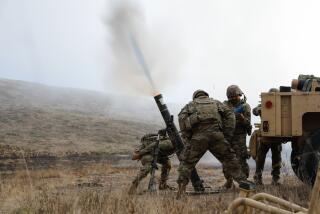Carrier Gets Joyous Reception
- Share via
SAN DIEGO — With flowers and flags, the 5,200 sailors and Marines of the U.S. aircraft carrier John C. Stennis returned home Tuesday to an emotional and joyous welcome from family members and a citizenry deeply linked to the military.
At the dock at North Island Naval Air Station in Coronado were 7,000 well-wishers. Several thousand more lined the shores of San Diego Bay to watch the nuclear-powered ship glide into port after a six-month deployment to the Arabian Sea, where it served as a platform for airstrikes on Afghanistan.
“God Bless Our Heroes,” said several banners in red, white and blue. Local media had given the arrival several days of “count-down” coverage.
This, after all, is San Diego, where the comings and goings of Navy ships and Marine units receive the kind of hoopla that in Los Angeles is reserved for the premiere of the latest would-be Hollywood blockbuster.
The war on terrorism may have dimmed in the consciousness of other communities. But not so in San Diego County, where there are more active-duty military than in any other county in the nation: 104,000, split almost evenly between sailors and Marines.
The tumultuous welcome given to the carrier--complete with proclamations from the mayors of San Diego and Coronado--was the outward sign of a deep interdependence between the military and the civilian population that dates back decades. The military pervades everything in this city, from history and politics to economics and social mores.
“In other places, they think about the military on Memorial Day, but in San Diego, every day is Memorial Day,” said Joe Jacobs, who arrived at North Island three hours early to make sure he could get a front-row seat for the arrival of the Stennis and his 19-year-old nephew.
“How important is the military to San Diego?” asked Tom Blair, editor of San Diego magazine. “Just open the window. You can still hear the howling over [U.S. Rep. Randall] Cunningham’s trial balloon about sending the Marine recruit depot to Orange County.”
In addition to active-duty personnel, there are 26,000 civilian workers and 60,000 retirees, making the military the county’s second-largest economic sector.
The first Tomahawk missile fired into Afghanistan came from a San Diego ship. The first conventional U.S. troops into Afghanistan were Marines from Camp Pendleton. More military personnel from San Diego have died in the war zone than from any region in the country.
The military contributes $9.8 billion a year to the local economy. It’s second only to manufacturing’s $25.4 billion.
“Money, money, money, and tradition, tradition, tradition, that’s what the military means to San Diego,” said political consultant Jack Orr.
The city’s strong ties to the armed services date to the early 20th century--when the San Diego Chamber of Commerce and local congressmen began assiduously courting the military.
A watershed in the civilian-military relationship came in 1923, when the Marine Corps opened its first West Coast training camp here and the Navy opened a new training site here, eclipsing an earlier one in San Francisco.
“Without the military, San Diego would be Pismo Beach,” said Mike Stepner, director of land-use planning and housing for the local Economic Development Corp. “The military has influenced everything about San Diego: our economy, our politics, even our mores.”
The San Diego Union-Tribune routinely runs a map on Sunday giving the location of San Diego-based ships deployed around the globe. The newspaper planned to devote several pages of coverage to the arrival of the Stennis. Three of the paper’s photographers were assigned to assure that no angle went uncovered.
Military stories--of training, new equipment, deployments or changes in benefits--are routinely given prominent coverage by local TV stations. The military beat is a prized assignment, trusted only to veteran reporters.
Two stations sent anchorpersons to the Arabian Sea to report on the Stennis. Though much of the military coverage is upbeat, there have been stories exposing drug use among active-duty personnel and substandard housing for military families.
Although there are other factors too, the military presence in San Diego County tends to reinforce the conservative nature of local politics. Military service is an important credential for candidates.
Two local congressmen--Duncan Hunter (R-Alpine) and Cunningham (R-Escondido)--are Vietnam veterans. Hunter was an Army Ranger; Cunningham a decorated Navy fighter pilot. Rep. Darrell Issa (R-Vista) served in the peacetime Army.
The husband of Rep. Susan Davis (D-San Diego) served a hitch in the Air Force. One community newspaper refers to her as “a former military spouse,” meant as a high compliment.
There are those, however, who say the military’s influence is not always positive.
“It’s very hard in San Diego to discuss issues of how big the military should be and how much money we should spend on it that could be used for schools, health care and potholes,” said Carol Jahnkow, executive director of the Peace Resource Center of San Diego. “So many people’s paychecks come from the military, it’s dangerous to discuss issues even with your neighbors. The military influence strangles political discussion.”
Josephine Thomas, daytime manager at the Trophy Lounge, a drinking and dancing emporium in National City, just a few miles from where the Stennis is docked, is more interested in the military’s economic impact. The Trophy Lounge bought advertising in the base newspaper beckoning Stennis sailors, with pictures of waitresses in shorts.
Similar advertising was purchased by Norm’s Cocktails in La Mesa and the Pure nightclub in San Diego; the latter promises free admission for Stennis sailors and plenty of techno and “progressive trance” music.
“The sailors are good for us and we’re good for the sailors,” said Thomas, who expects a large Stennis crowd. “That’s how it’s always been in San Diego.”
More to Read
Sign up for The Wild
We’ll help you find the best places to hike, bike and run, as well as the perfect silent spots for meditation and yoga.
You may occasionally receive promotional content from the Los Angeles Times.






